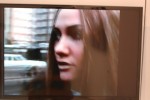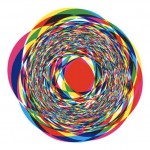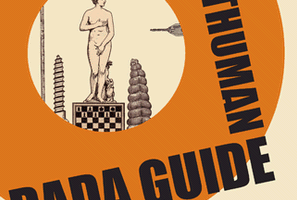Tom Sachs is a bricoleur with a difference. His scruffy “taped and glued found object and scrap” sculptures of guns, air conditioners, and whimsical fashion products (a Chanel guillotine; a Prada toilet) are high pop art and highly campy. That they also pack a political punch is to their credit. This is an artist who is a sharp social observer and a critic of capitalism’s big guns. And he loves nothing more than to recreate in loving albeit seemingly slap-dash fashion, a commodity that encapsulates our human desires, hopes, joys and foibles. And then skewer those human desires. He’s an interesting package. (Sachs visited Philadelphia in 2005 to give a talk at PAFA. Here’s Libby’s full report on that talk.)
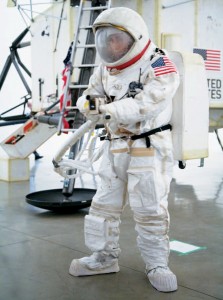
The book, Tom Sachs: Space Program, out this month, is about the artist’s 2007 project to recreate the Apollo lunar landing module and re-enact the 1969 Apollo 11 moon landing from countdown to splashdown, in a gallery in Los Angeles. The book — as the project — is deadpan great. It’s a gorgeous book that documents Team Sachs’ spacey achievement at Gagosian Gallery. Full of NASA technospeak and acrynyms, it’s tone is consistent with Sachs’ project mixing skepticism and gee whiz enthusiasm for the space program, for astronauts, for re-enactments and for art.
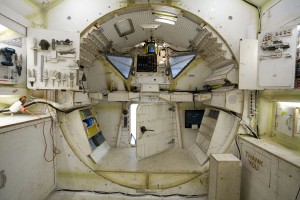
There are many diagrams and technical specs throughout the 280 pages, including a detailed countdown scenario; several blank pages with the tech-manual tag “THIS PAGE INTENTIONALLY LEFT BLANK” and an acronym glossary. At times it’s laugh out loud funny: The Al Green cassette tape has its own countdown “check” moment, for example. And some favorite acronyms include H2O-water; DJ-Disc jockey; MC-master of ceremonies; QB-(did you guess?) quarterback…sprinkled amongst the real NASA-esque mind-numbing acronyms.
And lest you think the book’s just some pretty pictures and lists and diagrams, it’s also got a couple lovely essays and a fabulous Q&A between Sachs and (real life Apollo 11 astronaut) Buzz Aldrin (read more about Aldrin and Apollo 11 here).
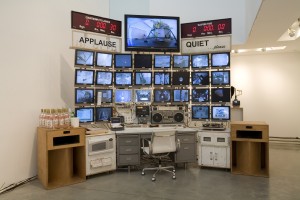
Arthur Danto‘s essay gives art historical gravitas to Sachs as a mischievous pop-ster and genius object maker. The Q&A between Sachs and Aldrin reveals, interestingly, two like-minded techno-geeks, one of whom happens to be the real thing (Aldrin) and the other of whom doesn’t have an engineer’s education or patience but sure loves the idea of engineering and technology (Sachs). Both men are equal parts seriousness and humor.
Here’s an example of Sachs’ gung-ho enthusiasm for the project (taken from the Q&A):
“When my astronaut took her first step on the Moon, or the gallery floor, we had rehearsed it so many times that we were sure that it was going to be disappointing. But when it finally happened, we all went crazy! We weren’t surprised because we were so prepared, but it was nevertheless a huge thrill and relief.” (P. 25)
There are almost 800 full color photos and many black and whites in the book. All printed on glossy photo paper, the Installation shots make the lunar module and Mission Control look like more or less believable replicas. Close-up shots reveal the DIY aesthetic with the gouges in the rough-worked plywood, tape everywhere and pencil marks and hand-written labels for the module’s control panel switches (my favorite-the simple “up” and “down” switch labeled “moon”).
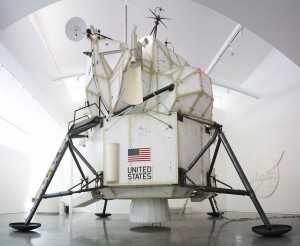
Sachs is a DIY magician and his ambition is full-throttle here and Space Program, the artwork, looks like it was a winner. And Space Program the book is a great encapsulation of the project.
This is not a cheap book–$65. But it’s a fun book and a great art monograph. And if you are a space buff, a Sachs buff, or just like a good documentation of a great whifty project, this is the book for you.
Space Program, like other Sachs projects, may be interpreted as a critique of commodification. For after all, NASA is on the front lines of commodifying space. It may also critique the government’s trading on our romance with space exploration to get a green light for NASA’s huge spending on R&D which ultimately helped the military more than us civilians. At the time of the cold war and the space race, there was national will to spend the money, but, really, in hindsight, our schools and infrastructure would be better off if we had spent the money on those earthly necessities.
But this is an ambivalent gentle poke at NASA. Because, as demonstrated in this book, while he’s got to question everything, when all is said and done, Sachs is in love with the technology and the human aspects of space exploration. And this project is as much a celebration as a critique.
Tom Sachs: Space Program
Gagosian Gallery
Rizzoli International
280 pages/ 8 1/2 x 11″/ 827 color and b&w illustrations
ISBN 13: 978-0-8478-3226-2
HC $65


